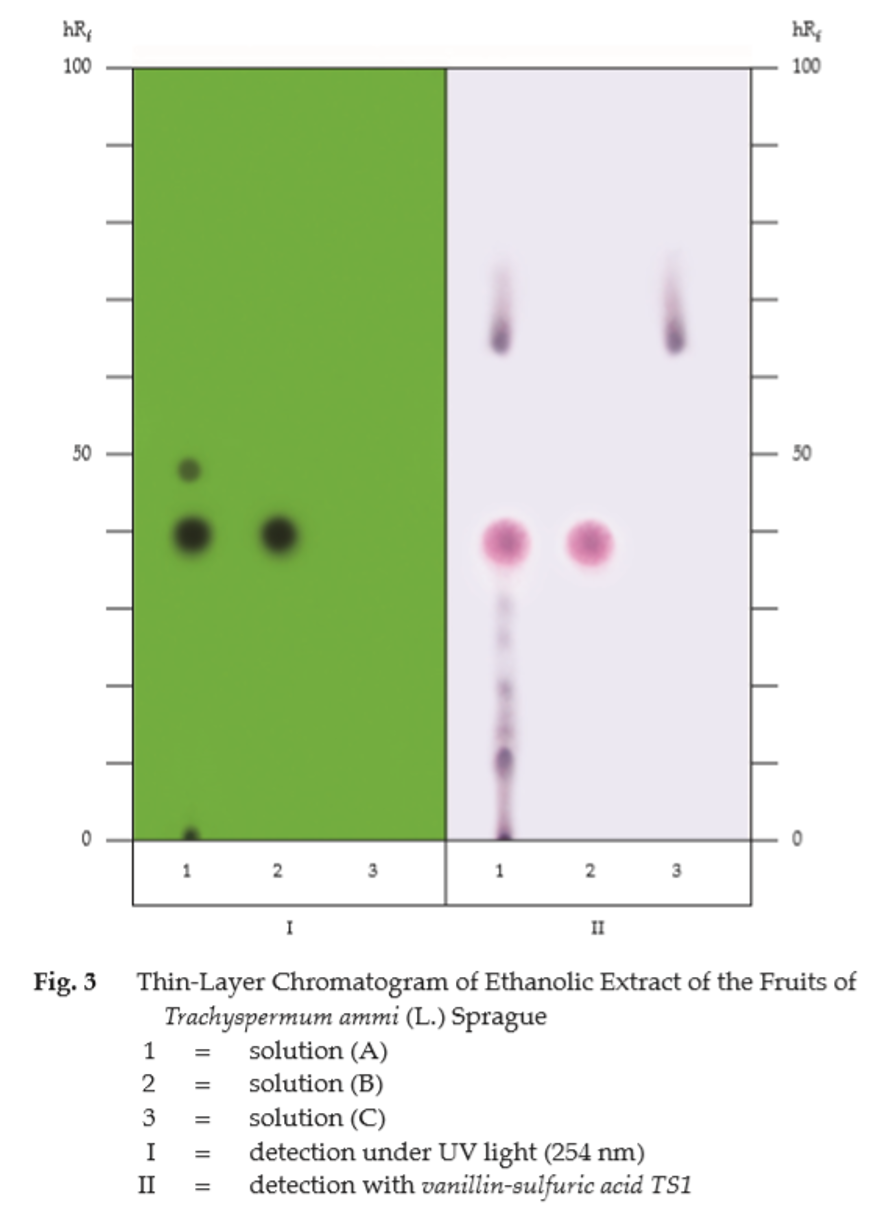ตำรามาตรฐานยาสมุนไพรไทย
Thai Herbal Pharmacopoeia
สำนักยาและวัตถุเสพติด กรมวิทยาศาสตร์การแพทย์ กระทรวงสาธารณสุข
Bureau of Drug and Narcotic, Department of Medical Sciences, Ministry of Public Health(Tinospora crispa (L.) Hook.f. & Thomson)
(Nelumbo nucifera Gaertn.)
(Centella asiatica (L.) Urb.)
(Centella Dry Extract)
(Centella Cream)
(Mesua ferrea L.)
(Piper sarmentosum Roxb.)
(Piper sarmentosum Roxb.)
(Pterocarpus santalinus L. f.)
(Santalum album L.)
(Senna tora (L.) Roxb.)
(Senna alata (L.) Roxb.)
(Senna Alata Tea)
(Piper retrofractum Vahl)
(Myristica fragrans Houtt)
(Andrographis paniculata (Burm. f.) Nees)
(Andrographis Capsules)
(Allium ascalonicum L.)
(Ocimum tenuiflorum L.)
(Curcuma longa L.)
(Turmeric Capsules)
(Turmeric Dry Extract)
(Turmeric Dry Extract Capsules)
(Arcangelisia flava (L.) Merr.)
(Curcuma sp.)
Harrisonia perforata (Blanco) Merr.
(Aristolochia pierrei Lecomte)
(Zingiber officinale Roscoe)
(Ginger Capsules)
(Ginger Tea)
(Cassia fistula L.)
(Nardostachys jatamansi (D. Don) DC.)
(Angelica sinensis (Oliv.) Diels)
Artemisia annua L.
(Ligusticum sinense Oliv. cv. Chuanxiong)
(Neopicrorhiza scrophulariiflora Pennell)
(Atractylodes lancea (Thunb.) DC.)
(Aucklandia lappa Decne)
(Terminalia chebula Retz.)
(Angelica dahurica (Hoffm.) Benth. & Hook. f. ex Franch. & Sav. var. dahurica)
(Kaempferia parviflora Wall. ex Baker)
(Hibiscus sabdariffa L.)
(Roselle Tea)
(Allium sativum L.)
(Zingiber zerumbet (L.) Sm.)
(Wurfbainia testacea (Ridl.) Škorničk.& A. D. Poulsen)
(Cannabis sativa L.)
(Myristica fragrans Houtt)
(Dracaena cochinchinensis (Lour.) S. C. Chen)
(Ficus racemosa L.)
(Hyptis suaveolens (L.) Poit.)
Clerodendrum indicum (L.) Kuntze
(Phyllanthus emblica L.)
(Citrus hystrix DC.)
(Citrus hystrix DC.)
(Areca catechu L.)
(Momordica charantia L.)
Moringa oleifera Lam.
(Aegle marmelos (L.) Corrêa)
(Solanum trilobatum L.)
(Morus alba L.)
Gynostemma pentaphyllum(Thunb.)
Makino
(Clinacanthus nutans (Burm. f.) Lindau)
(Cissus quadrangularis L.)
(Mimusops elengi L.)
(Zingiber montanum (J. König) Link. ex A. Dietr.)
(Piper betle L.)
(Capsicum annuum L.)
(Capsicum Oleoresin)
(Capsicum Gel)
(Piper nigrum L.)
(Piper nigrum L.)
(Eurycoma longifolia Jack)
(Thunbergia laurifolia Lindl.)
(Piper wallichii (Miq.) Hand.-Mazz.)
Senna garrettiana (Craib) H. S. Irwin & Barneby
(Terminalia bellirica (Gaertn.) Roxb.)
(Terminalia chebula Retz.)
(Caesalpinia bonduc (L.) H. Roxb.)
(Tarlmounia elliptica (DC.) H. Rob., S. C. Keeley, Skvaria & R. Chan)
(Hog Creeper Vine Dry Extract Capsiles)
(Hog Creeper Vine Dry Extract)
(Brachypterum scandens (Roxb.) Miq.)
(Lepidium sativum L.)
(Nigella sativa L.)
(Cuminum cyminum L.)
(Foeniculum vulgare Mill.)
(Plantago ovata Forssk.)
(Pimpinella anisum L.)
(Carum carvi L.)
(Anethum graveolens L.)
(Trachyspermum ammi (L.) Sprague)
Albizia procera (Roxb.) Benth.
(Acorus calamus L.)
(Tiliacora triandra (Colebr.) Diels)
Cyanthillium cinereum (L.) H. Rob.
(Orthosiphon aristatus (Blume) Miq.)
Murdannia loriformis (Hassk.) R. S. Rao & Kammathy
(Capparis micracantha DC.)
(Chrysopogon zizanioides (L.) Roberty)
(Cyperus rotundus L.)
(Cannabis sativa L.)
(Syzygium aromaticum (L.) Merr. & L. M. Perry)
(Boesenbergia rotunda (L.) Mansf.)
(Acanthus ebracteatus Vahl)
(Acanthus ilicifolius L.)
(Kaempferia galanga L.)
(Curcuma comosa Roxb.)
Betula alnoides Buch.-Ham. ex D. Don
Cannabis sativa L.
Carthamus tinctorius L
Mitragyna speciosa (Korth.) Havil
Mallotus repandus (Rottler) Müll. Arg
Azadirachta indica A. Juss. var. siamensis Valeton
Azadirachta indica A. Juss. var. siamensis Valeton
Punica granatum L.
Rhinacanthus nasutus (L.) Kurz
Baliospermum solanifolium (Burm.) Suresh
Curcuma aeruginosa Roxb
Boesenbergia kingii Mood & L. M. Prince
Senegalia rugata (Lam.) Britton & Rose
Acacia concinna (Willd.) DC.
Senegalia rugata (Lam.) Britton & Rose
Acacia concinna (Willd.) DC.
Senna alexandriana Mill. var. alexandriana
Cassia acutifolia Delile, Cassia angustifolia Vahl
Butea superba Roxb. ex Willd.
[Plaso superba (Roxb. ex Willd.) Kuntze, Rudolphia superba (Roxb. ex Willd.) Poir.
Pueraria candollei Graham
ex Benth. var. mirifica (Airy Shaw & Suvat.) Niyomdham
Streblus asper Lour.
Suregada multiflora (A. Juss.) Baill. (Gelonium
multiflorum A. Juss.
Ajowan is the dried ripe fruit of Trachyspermum ammi (L.) Sprague [Sison ammi L., Carum copticum Benth. & Hook. f., Trachyspermum copticum (L.) Link] (Family Umbelliferae), Herbarium Specimen Number: DMSC 4537, 4538, 4539, QSBG 22814, 23820, 23819, Crude Drug Number: DMSc 428.
Constituents Ajowan contains volatile oil, of which thymol, γ-terpinene and p-cymene are its major components. It also contains flavonoids, coumarins, proteins, etc.
Description of the plant (Figs. 1a, 1b) Annual herb 25 to 45 cm tall; taproot narrow; stem erect, terete, much-branched, glabrous, aromatic. Leaves, triangular-ovate in outline, 2 to 8 cm long, 2 to 6 cm wide, 2- to 3-pinnate or pinnatisect; ultimate segments linear-filiform, up to 15 mm long, 0.2 to 0.5 mm wide; petiole 1 to 5 cm long. Inflorescence compound umbels, 2.5 to 5 cm across; bracts 3 to 8, linear-subulate, 5 to 7 mm long; rays 6 to 20, 1 to 3 cm long; bracteoles 5 to 10, linear, 2 to 3 mm long; umbellules about 1 cm across, about 20-flowered; pedicel 0.5 to 4 mm long, unequal; calyx teeth conspicuous, minute, ovate or obsolete; petals 5, white, obovate to obcordate, about 1.3 mm long and wide, apex, inflexed; stamens 5; stylopodium conical, style short, divaricate. Fruit cremocarp, ovoid-globose, 1.2 to 3.1 mm long, 1 to 1.8 mm wide; carpophore 2-cleft to base.
Description Odour and taste, aromatic and characteristic.
Macroscopical (Figs. 1a, 1b) Cremocarp, brown, broadly ovoid with short conical stylopodium, 2 mericarps frequently separated, crescent-shaped, 1.2 to 3.1 mm long, 1 to 1.8 mm wide. Dorsal surface convex, with 5 lighter-coloured prominent longitudinal ridges alternating with roughened furrows; commissural surface concave, with a carpophore and a pedicel.
Microscopical (Figs. 2a, 2b) Transverse section of the mericarp through the cotyledon shows an epicarp layer, epidermal cells covered with striated cuticle layer, numerousthick-walled papillae of small and large sizes. Large papilla, surrounded by about 6 small papillae. Mesocarp, several layers of elongated parenchyma cells, some collapsed, and 5 vascular bundles alternated with the epithelium tissues of elliptical brown vittae. Endocarp and seed coat united, with triangular raphe at the ventral side. Endosperm, thick-walled, polygonal parenchyma cells containing oil globules, aleurone grains and rosette aggregate crystals. Cotyledon, parenchyma cells with aleurone grains and oil globules.
Ajowan in powder possesses the diagnostic microscopical characters of the unground drug.
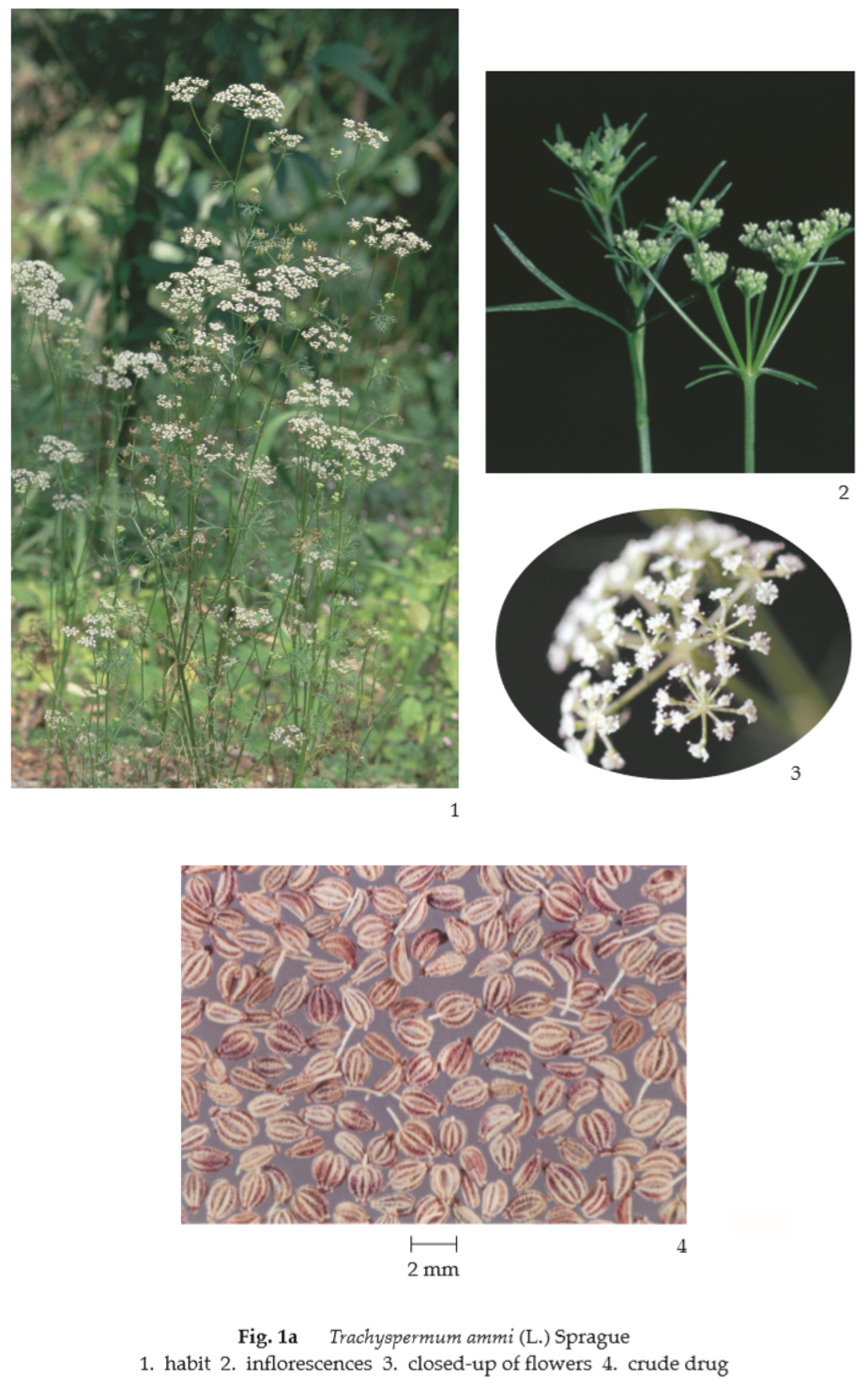
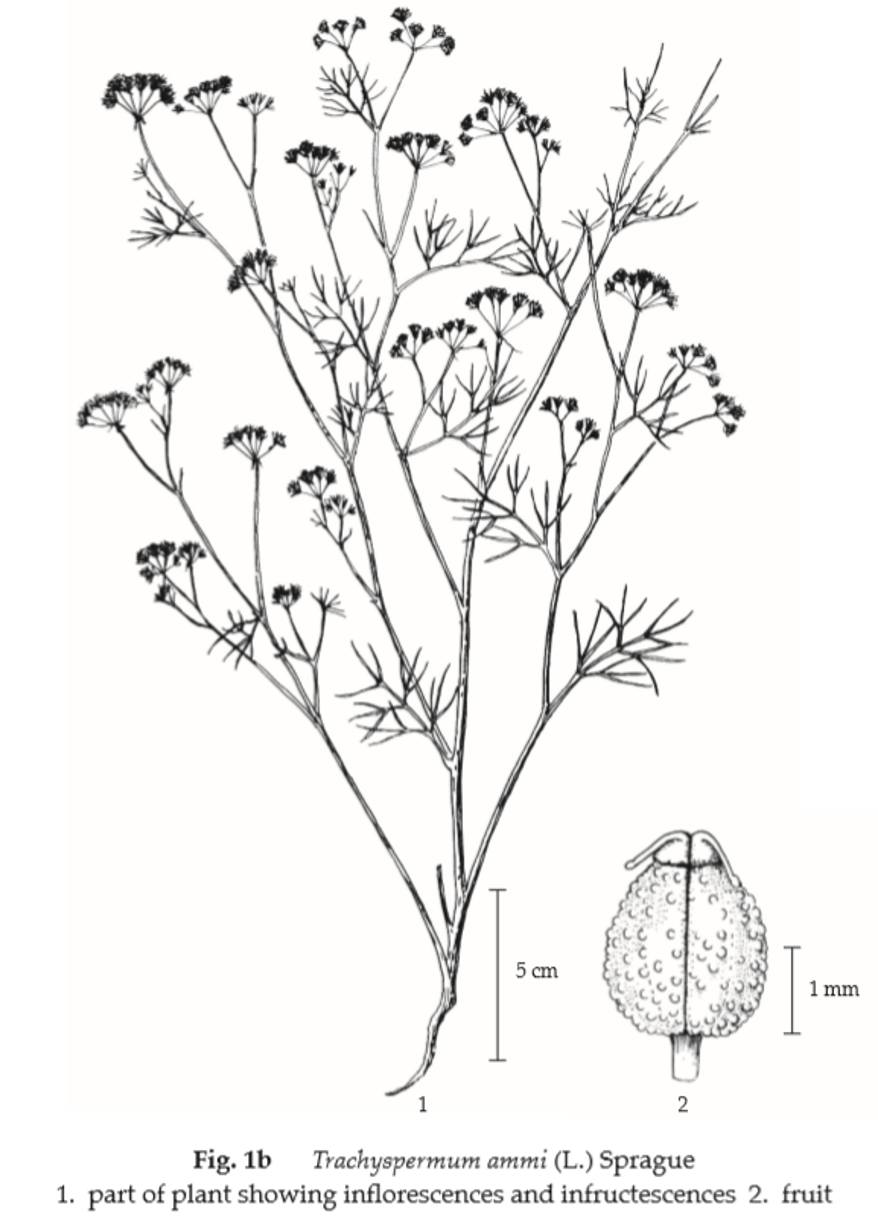
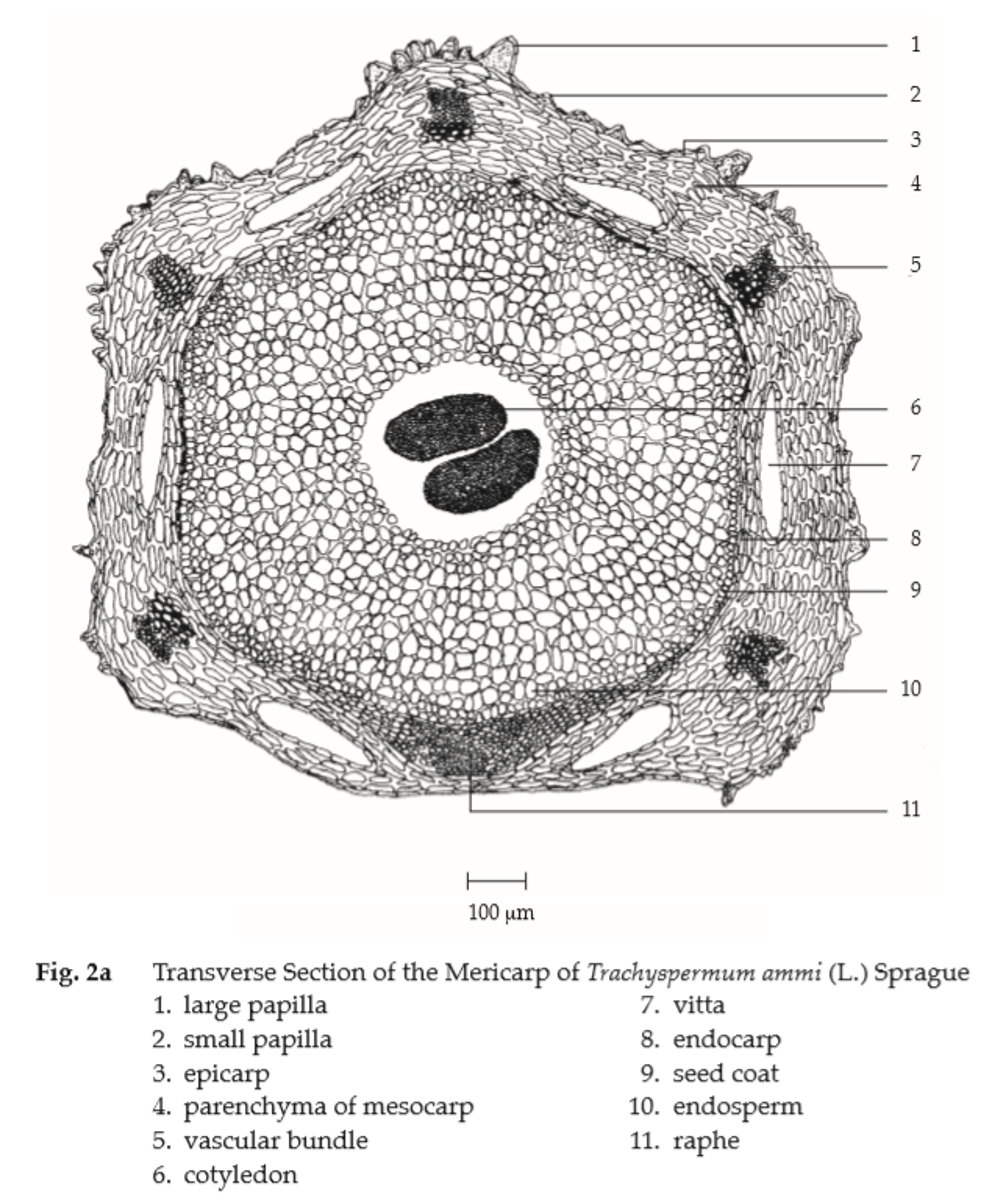
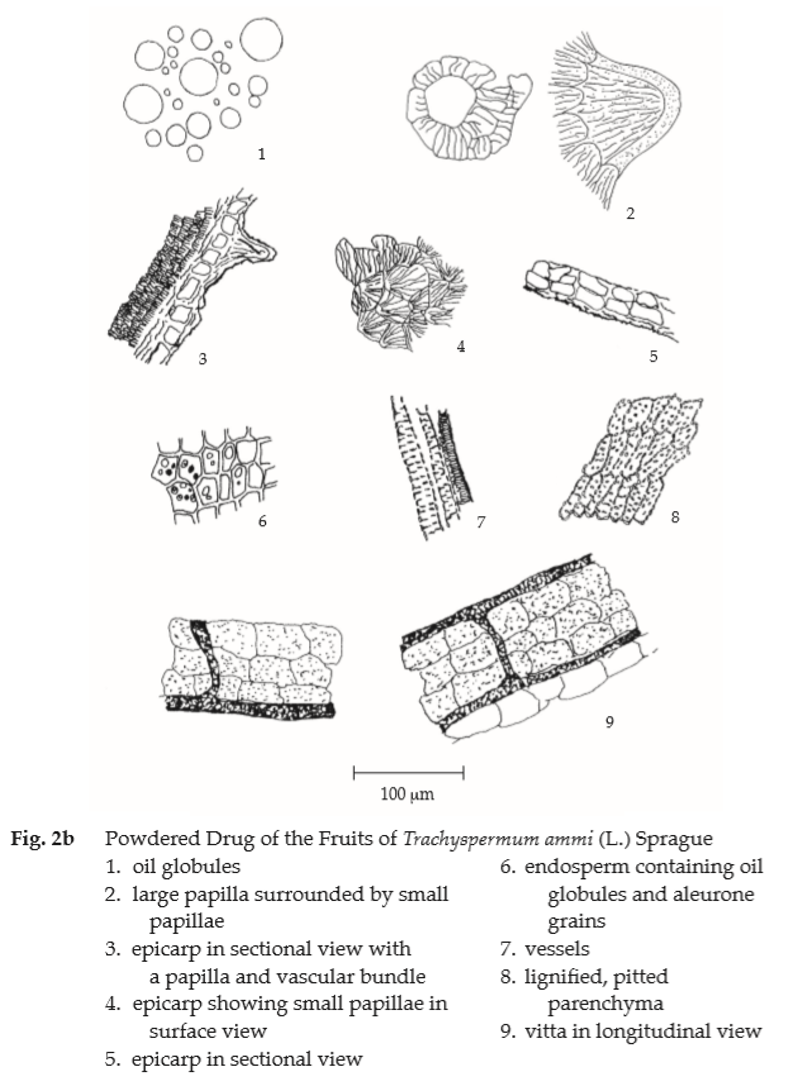
Additional information It is commonly used with other herbal drugs in Thai traditional herbal preparations.
Packaging and storage Ajowan shall be kept in well-closed containers, preferably of metal or glass, protected from light and stored in a cool and dry place.
Identification
A. Extract 1 g of the sample, in No. 850 powder, with 5 mL of petroleum ether (boiling range, 40° to 60°) and filter. Evaporate the filtrate to dryness under the current of air, dissolve the residue in 1 mL of glacial acetic acid, add 6 drops of sulfuric acid, and then 1 drop of nitric acid: a deep bluish green colour develops.
B. Extract 2 g of the sample, in No. 850 powder, with 5 mL of petroleum ether (boiling range, 40° to 60°) and filter. Evaporate the filtrate to dryness under the current of air, dissolve the residue in 2 mL of a 10 per cent w/v solution of sodium hydroxide and heat on a water-bath for a few minutes. Cool the solution, add a few drops of chloroform and shake: a violet colour is produced.
C. Carry out the test as described in the “Thin-Layer Chromatography” (Appendix 3.1), using silica gel GF254 as the coating substance and a mixture of 93 volumes of toluene and 7 volumes of ethyl acetate as the mobile phase. Apply separately to the plate, 4 μL each of the following solutions. Prepare solution (A) by extracting 1 g of the sample, in No. 850 powder, with 2 mL of ethanol and filtering. For solution (B), dissolve 3 mg of thymol in 1 mL of ethanol. For solution (C), dissolve 4 μL of olive oil in 1 mL of ethyl acetate. After removal of the plate, allow it to dry in air and examine under ultraviolet light (254 nm), marking the quenching spots. The chromatogram obtained from solution (A) shows a quenching spot (hRf value 38 to 40) corresponding to the thymol spot from solution (B) and one spot of higher hRf value. Spray the plate with vanillin-sulfuric acid TS1; the spot due to thymol is pink. One violet spot (hRf value 65 to 68) corresponds to triglycerides of olive oil from solution (C). Other several spots are also observed (Table 1); see also Fig. 3.
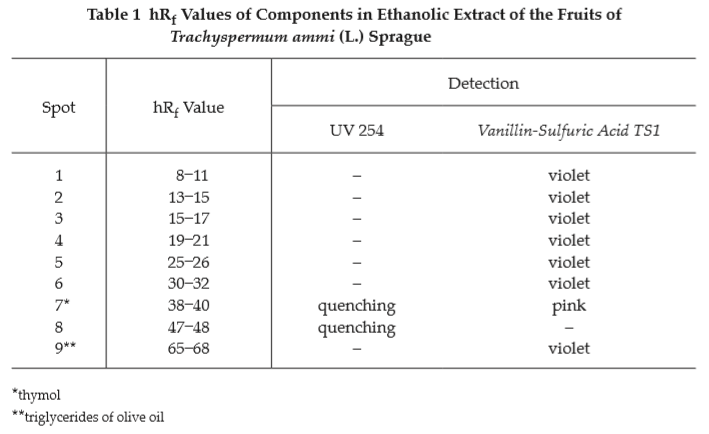
Water Not more than 11.0 per cent v/w (Azeotropic Distillation Method, Appendix 4.12).
Foreign matter Not more than 4.0 per cent w/w (Appendix 7.2).
Acid-insoluble ash Not more than 2.0 per cent w/w (Appendix 7.6).
Total ash Not more than 12.0 per cent w/w (Appendix 7.7).
Ethanol-soluble extractive Not less than 8.0 per cent w/w (Appendix 7.12).
Volatile oil Not less than 5.0 per cent v/w (Appendix 7.3 H). Use 20 g, in No. 850 powder, freshly prepared and accurately weighed. Use 200 mL of water as the distillation liquid and a 500-mL round-bottomed flask. Distil at a rate of 2 to 3 mL per minute for 4 hours. Use 1.0 mL of xylene in the graduated tube.
